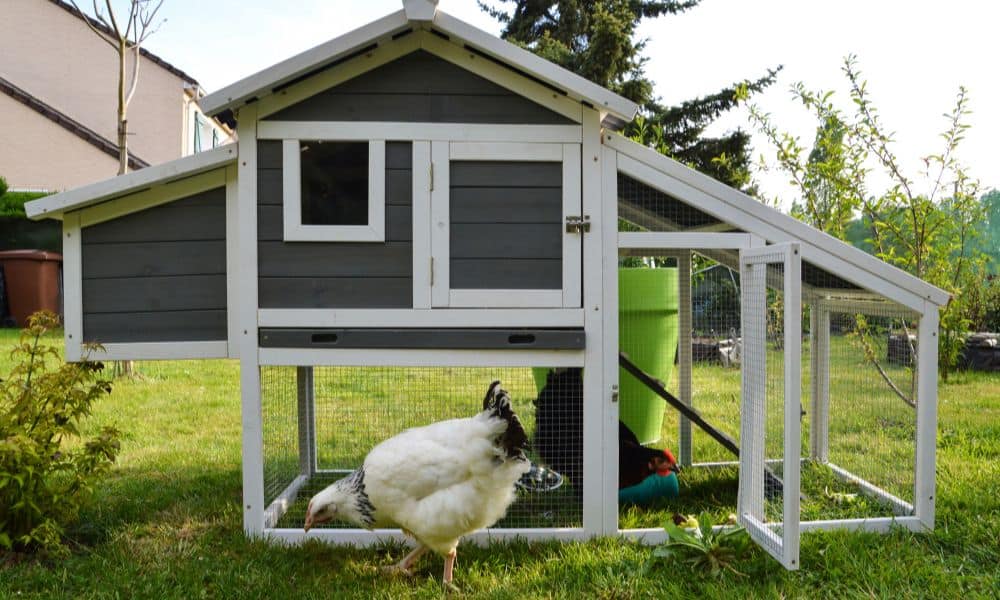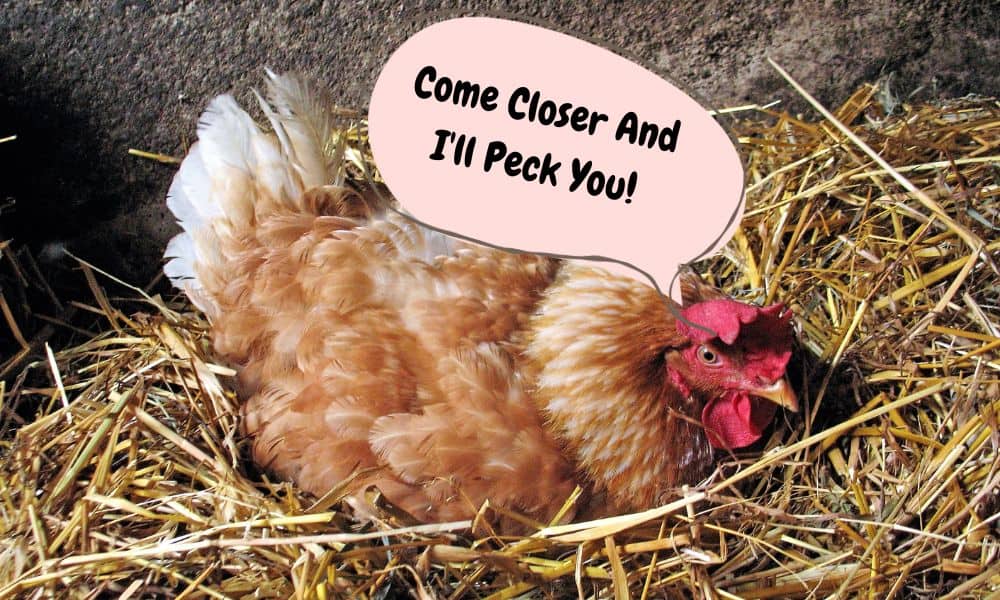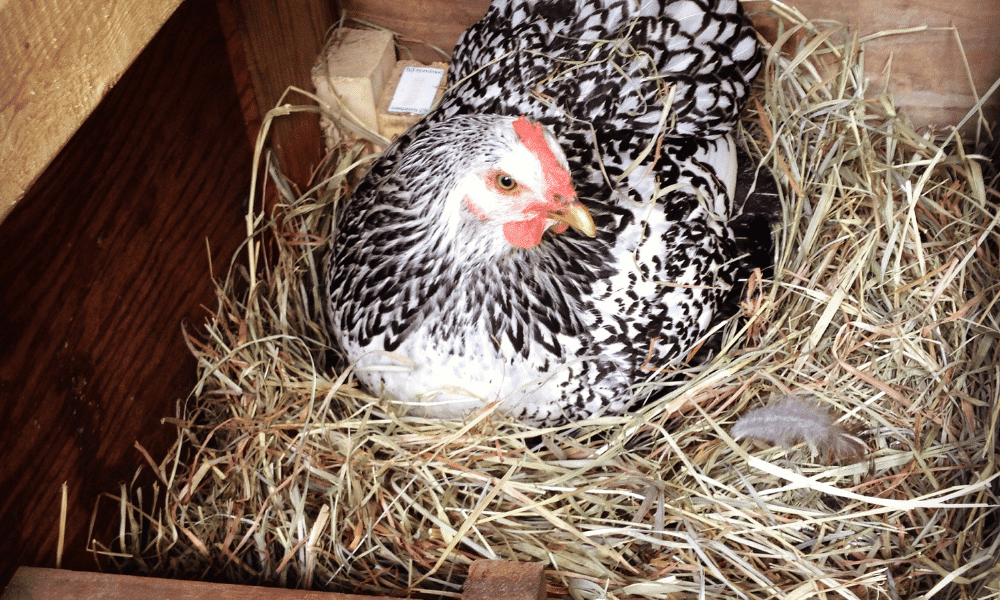Got a particularly broody hen, have you?
Or maybe it’s just the first time your hens become broody and you’re sitting there pulling your hair out, wondering how it can possibly be normal for them to simply refuse to leave the nesting box for days on end!
Well, ask any chicken owner and we’ll all say we’ve been there.
But just how often is it considered “normal” for a hen to go broody?
Here are what factors influence broodiness in hens, how often you can expect hens to go broody, and some valuable tips on how to deal with broody hens.
Contents
Understanding Broodiness In Hens
As equally hilarious and frustrating as broodiness in hens can be, the cause of the behavior is incredibly fascinating.
Broodiness is a natural instinct in hens, triggered by a change in hormones giving the hen the ultimate desire to sit on, protect, and hatch its eggs.
This change in hormones can be brought on after a period of egg-laying, changes in the amount of daylight, and the presence of eggs in their nesting box.
Of course, even without the presence of fertilized eggs, or eggs at all for that matter, the same hormonal change can take place, causing a hen to go broody anyway.
This broody behavior is also accompanied by a few notable physiological changes, including increased body temperature, refusal to leave their nesting box, and drastically reduced eating and drinking.
How Many Times A Year Will A Hen Go Broody?

Broodiness is the bane of any chicken owner that loves a consistent stream of freshly laid eggs.
So, it’s only natural that you want to know how often one of your prime producers is going to go on an egg-laying hiatus and become broody.
Although there’s no certainty as to how many times any given hen will go broody over a year, most regularly laying hens will go broody between 3-8 times per year.
Of course, this can depend highly on a variety of factors such as your chicken’s age, environment, and diet. As well as this, one of the most prominent factors is actually the breed of chicken!
Factors Which Affect Broodiness
Although there may be many different nuances that can affect a hen’s broodiness levels, the most prominent factors which influence the broodiness of any given hen include:
- The Hen’s Age: Hens tend to be less broody over their first six months of egg laying, and more broody after a year of egg laying.
- The Season: Daylight directly impacts a hen’s egg-laying cycle. It’s more likely hen’s will become broody during the months of the year with shorter days, as there is less light to stimulate further, continuous egg production.
- Diet: If hens aren’t getting their optimal nutrition for egg laying (such as protein and calcium, etc) then it’s more likely that a pause in their egg laying caused by diet will be accompanied by broodiness.
- The Breed Of Chicken: some chicken breeds have higher tendencies to become broody (like Silkies), whereas some chicken breeds almost never become broody (commercial production breeds).
Heritage Breeds Vs. Commercial Breeds
The vast difference in how often a heritage breed goes broody compared to a commercial breed warrants further explanation.
You see, commercial breeds (like White leghorns, Rhode Island Reds, ISA Brown, etc.) have been selectively bred to maximize their egg production, and subsequently become much less broody as they are consistently producing eggs.
On the other hand, Heritage breeds (those that are naturally bred and are the most prominent for typical backyard farming and companionship) tend to go broody more often simply because they are not selectively bred not to!
What Chicken Breeds Are the Most Broody?

If you’ve got an unusually broody hen, chances are it could be because their breed carries a higher tendency to go broody.
Here are the top contenders for producing the Broody Mama of the Year:
- Silkies
- Cochins
- Australorps
- Plymouth Rocks
- Sussex
- Orpingtons
- Brahmas
In fact, some heritage breeds are actually so good at brooding over their eggs that some breeders use them to hatch other chicken breeds’ eggs or even other poultry eggs too (like Silkies!).
How To Spot A Broody Hen

Here are the typical signs you’ve got yourself a broody hen:
- Barely leaving the nesting box (usually just once a day for food and water).
- Trills/Purrs when you get close to her.
- Try to peck you when collecting their eggs.
- Sometimes plucks their own belly feathers.
- Can produce worse smelly droppings due to lack of water!
How Long Does Broodiness Last In Hens?
Alright, so one of your hens has gone broody. You may be thinking, how long will this madness go on?
Well, typically broodiness can last anywhere from 15-21 days (give or take), which is usually the amount of time it would take to actually hatch eggs!
Of course, this timeframe can be shortened with some safe intervention techniques.
Dealing With A Particularly Broody Hen

Just to preface, it’s perfectly safe to wait out the broodiness of your hens. But, for those that want to maximize their egg production, there are a few safe and humane ways to “break” the broodiness of any Broodzilla in your flock.
Regularly Remove Her From The Nesting Box
If your broody hen isn’t exhibiting any protective pecking behavior then it’s perfectly safe to simply pick her up and remove her from the nesting box.
I sometimes do this to simply encourage them to eat and drink more, which can help break the broodiness cycle too.
This also gives them an opportunity to stretch out their wings and legs!
It’s funny, sometimes they will literally just squat down where you put them for a while before they finally get up and walk about.
Shut Her Out Of The Nesting Box
If you remove your broody hen from the nesting box but they immediately make their way back to it, then you may want to move to slightly more effective methods to break the broodiness.
To help break broodiness you can simply shut the entrance to the nesting boxes for a while.
Of course, unfortunately, this stops your other hens from gaining access too. You won’t want to do this for too long as you may find your other hens laying elsewhere too!
The other problem is sometimes your broody hen will find another place in your yard to become broody too!
Put Her In Chicken Jail
Since merely blocking access to the nesting box can have an adverse effect on your other laying hens, another technique is to simply separate the broody hen for a matter of days in a separate coop or location.
After a day or so separated from their usual environment and flock they tend to break out of the broodiness!
We call this “chicken jail” and can also be used to deal with any aggressive hens or roosters too.
Give Her A Cold Bath
If nothing else is working, you can try giving Broodzilla a nice cold bath.
Simply fill up a suitable tub with mildly cold water (just colder than room temperature is fine), and place your broody hen inside, just deep enough so that the water hits her belly.
This change in environment and ambient body temperature can help shake off any particularly broody feelings.
I would only resort to this method if you’re really impatient, as you don’t want to cause any unnecessary stress in your hens – whether they’re broody or not!
How To Discourage Hens From Going Broody
If your hens are going broody left, right, and center, then it’s best you do a bit of a review of your environment and habits to make sure you’re doing everything possible to discourage any broodiness in your hens.
Here’s what you can do to be proactive in the war against overly broody hens:
Collect Eggs Promptly
One trigger of broodiness is the sight of eggs in the nesting box.
This is one of the many reasons why it’s so important to do a daily egg collection. Most of the time a chicken will lay their eggs in the morning, but if you’re finding eggs throughout the day it can even be worth doing an egg collection twice a day.
Limit The Amount Of Nesting Boxes
It’s important to have enough nesting boxes for your flock.
But, having too many nesting boxes may actually encourage your hens’ to go broody more often, or stay broody for longer.
Normally if a hen needs to lay an egg but the nesting box is occupied, they will nicely “ask” that hen to move, so they can do their bidding.
But, if there are excess nesting boxes, then broody hens can go unbothered for a lot longer!
Can A Hen Die From Broodiness?
Don’t worry. In the vast majority of circumstances, there is absolutely no risk of harm to your hens if they are particularly broody.
Broody hens will always leave their nesting box for food and water. Even if it’s only once a day they won’t completely forgo food, water, and general hygiene.
In saying that, if your hen is actually sick or fighting injury, then becoming broody can worsen the condition as they eat and drink much less.
The good news is chickens in this kind of state don’t usually become broody anyway!
Wrapping Up
So, for any chicken owner who’s raising heritage breed chickens, you can expect your hen’s to go broody every few months, or around 3 – 8 times a year.
Of course, this can depend on their age, environment, diet, and most importantly: their breed.
For those raising commercial chicken breeds, it’s likely your hens will only go broody once or twice a year – if that!
If you’re dealing with a particularly broody hen, you can try a few safe and humane ways to break the cycle. AND more importantly, you should always collect your eggs daily, and have an adequate amount of nesting boxes to discourage any future broodiness.
